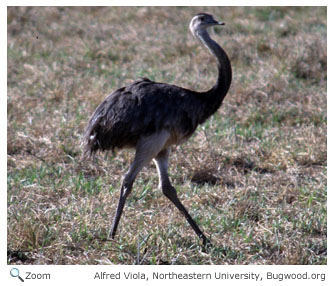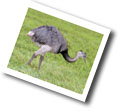|
 There are two species of birds in this family. They are found on grasslands in South America. There are two species of birds in this family. They are found on grasslands in South America.
Rheas eat leaves, roots, seeds, grass, insects, and small mammals, reptiles, and amphibians. Rheas have long necks; long, powerful legs; and shaggy gray feathers.
The male rhea mates with as many as 8 females. Each female lays as many as 20 eggs in a single nest. The male incubates the all the eggs for 35-40 days.
Male rheas have been known to incubate as many as 60 eggs at a time! The male cares for the chicks and charges after any threat that comes to close to his chicks!
 Rheidae Photo Gallery Rheidae Photo Gallery
World Status Key
 Least Concern Least Concern  Near Threatened Near Threatened  Vulnerable Vulnerable  Endangered Endangered  Critically Endangered Critically Endangered  Extinct in Wild Extinct in Wild  Extinct Extinct
Status and range is taken from ICUN Redlist. If no status is listed, there is not enough data to establish status.
US Status Key
 Threatened in US Threatened in US  Threatened in NH Threatened in NH  Endangered in US Endangered in US  Endangered in NH Endangered in NH  Introduced Introduced
Status taken from US Fish and Wildlife and NH Fish and Game
New Hampshire Species |
|
North/Central American Species |
None
|
|
None |
|


